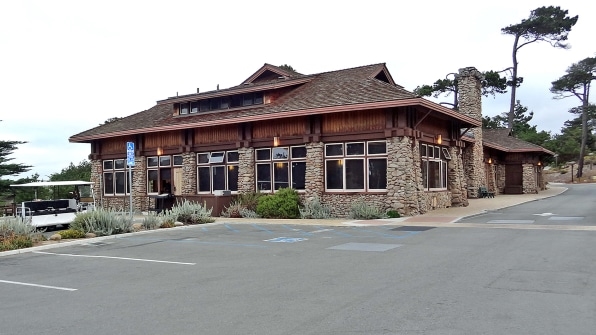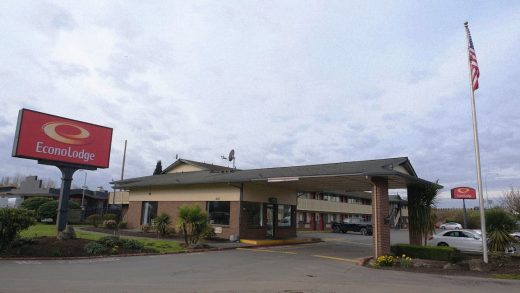Luxury resorts, tiny homes, RVs: How architecture is adapting in the age of coronavirus
One evening in early March, a white van pulled into the parking lot of an EconoLodge motel in the city of Kent, Washington, just south of Seattle. A worker extended a long roller and began painting the motel’s sign black. No longer a motel, the building was beginning a new life as a quarantine facility for people who’ve been exposed to the coronavirus and the disease it causes, COVID-19.
The 84-room motel, which had been on the market for about a month, was purchased for $4 million a few days before. King County officials had bought it to help deal with what had become the country’s highest concentration of COVID-19 cases. A statement from the office of King County Executive Dow Constantine said the motel was “the only site on the market” that met the physical requirements to safely contain the disease. All of its rooms have easily cleaned hard-surface floors, can be accessed individually without entering an enclosed hallway, and are equipped with their own HVAC equipment that doesn’t share airflow with other rooms. To keep infected people separated and treatable without occupying valuable hospital space, the motel offered a quick solution.
King County is far from alone in needing to adapt spaces to respond to the challenges presented by this coronavirus. In other hotspots across the country – from California to New York – patients and people who’ve been exposed are being treated in military bases and other state-owned facilities, but this could soon expand. Mike Cook, a partner at the Innova Group, a healthcare planning consultancy, says hotels, motels, and vacant school dormitories are good candidate spaces. “Private rooms with toilets are priorities number one and number two,” he says. Spaces also need easily cleanable surfaces, ventilation that won’t spread contagious aerosols, and, for psychosocial purposes, television or internet access to keep people entertained or occupied. “If you’re going to put a person in a room for two weeks, it’s more than just monitoring their health,” Cook says.

More quarantine spaces may soon be activated. On March 12, California Governor Gavin Newsom issued an executive order empowering the state Health and Human Services Agency and the Office of Emergency Services to identify and potentially commandeer hotels, temporary residences, and medical facilities that would be suitable for COVID-19 quarantine, isolation, and treatment. Some have already been called to action. Passengers from a cruise ship that reported a dozen cases of infection are currently being held in isolation at the oceanside Asilomar Hotel and Conference Grounds in Monterey County. With rooms designed by famed California architect Julia Morgan that run over $200 a night, it’s a seemingly posh containment zone, but it also happens to be a publicly owned facility within the California State Parks department. While it houses passengers from the ship, all regular operations at Asilomar have been suspended until April 13, with refunds offered to affected guests. Others from the ship have been sent for 14-day quarantine at a privately owned hotel in San Carlos, halfway between San Francisco and San Jose.
It’s likely that other nontraditional spaces will be utilized for quarantine and treatment, according to Juliet Rogers, president of Blue Cottage of CannonDesign, a global architecture and design firm with a large healthcare portfolio. Rogers, who has a PhD in public health and years of experience working with academic medical centers, says hospitals around the country are beginning to think outside their campuses.

“Many large systems are looking at can we convert either a hospital that’s underutilized right now or a hospital that’s been turned into an ambulatory care center? Could we use a hotel?” she says. “But all of those types of things have been used in different situations where we had surge that we had to respond to.”
As the numbers of affected people rise, health officials should start to consider a broader range of alternatives, she argues. And this isn’t just limited to quarantines. In a recent post on her LinkedIn page, Rogers suggested that hospitals create new assessment and treatment facilities like fast food-style drive-throughs where people can be evaluated without leaving their cars. One commenter recommended using vacant stores in strip malls for patient screening. Another proposed turning empty big box stores into ad hoc medical facilities.
Some places are already starting to act. In Seattle, efforts to safeguard the city’s vulnerable homeless population have accelerated plans for a 26-unit tiny home village in the Central District, with occupancy expected later this month. And in San Francisco, another city with a sizable homeless population at risk of infection, officials are setting up around 30 recreational vehicles to serve as isolation housing for people exposed to the virus who don’t need to be hospitalized.
Healthcare providers are also responding. A drive-through test site capable of handling up to 500 people a day just opened in New Rochelle, New York, the center of that state’s outbreak. And University of California San Francisco Health has just built two temporary “accelerated care units” outside one of its hospitals where doctors can triage patients and separate the symptomatic from the so-called “worried well” – cautious people who seek care that they don’t actually need. Cook says this screening and testing is a key first step in dealing with a pandemic. “You’ve got to keep the sheer numbers from overwhelming your healthcare system,” he says. Plenty of places may qualify to serve as quarantine zones, but they’ll only be useful if we know who needs to be isolated.
(8)



